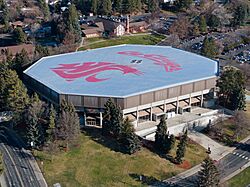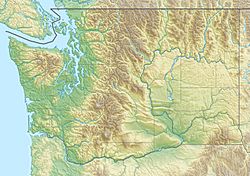Beasley Coliseum facts for kids

Aerial view from southwest in 2024
|
|
| Full name | Beasley Coliseum |
|---|---|
| Former names | Washington State University Performing Arts Coliseum (1973–1981) |
| Address | 925 NE North Fairway Rd. |
| Location | Washington State University Pullman, Washington, U.S. |
| Coordinates | 46°44′6″N 117°9′27″W / 46.73500°N 117.15750°W |
| Elevation | 2,550 feet (775 m) AMSL |
| Owner | Washington State University |
| Operator | Washington State University |
| Capacity | 12,058 |
| Construction | |
| Broke ground | February 8, 1971 |
| Opened | June 3, 1973 |
| Construction cost | $8.5 million ($56 million in 2022 ) |
| Architect | John Graham & Company |
| Tenants | |
| Washington State Cougars - NCAA (1973–present) |
|
Beasley Coliseum is a large indoor stadium located at Washington State University (WSU) in Pullman, Washington. It's the home court for the WSU men's and women's basketball teams, known as the Cougars. The arena first opened its doors in 1973. Today, it can hold up to 12,058 people for basketball games.
The building was renamed in 1981 to honor Wallis Beasley. He was a long-time professor and a very important leader at WSU. Before its renaming, the venue was called the "Washington State University Performing Arts Coliseum" for eight years. The Coliseum was built using a special "space frame" design, which was quite new at the time.
Contents
First Events at Beasley Coliseum
The very first event held at Beasley Coliseum in 1973 was WSU's graduation ceremony on June 3. Soon after, it hosted its first sports event: a professional basketball game between the Seattle SuperSonics and the Portland Trail Blazers on September 25, 1973.
The first big concert featured the band Three Dog Night on October 5. Tickets cost five dollars. The first college basketball game was on December 1, 1973. The WSU men's team played against LSU. Before Beasley Coliseum, college basketball games were played in Bohler Gymnasium, which is now used for volleyball.
Friel Court: A Special Name
The basketball court inside Beasley Coliseum is called Friel Court. It's named after Jack Friel (1898–1995), who was a legendary coach for the WSU men's basketball team. He led the Cougars to an amazing 495 wins over 30 seasons!
After coaching, Friel became the first leader of the Big Sky Conference, a group of college sports teams. The court was officially named in his honor in 1977. For its first ten years, the court had a special Tartan (rubber-like) surface. But in 1983, it was replaced with a traditional hardwood floor, which is what you usually see in basketball arenas.
NCAA Basketball Tournament Games
Beasley Coliseum has hosted parts of the NCAA men's basketball tournament three times. This tournament is a huge competition where college teams from all over the country play to find the national champion. The Coliseum hosted games in 1975, 1982, and 1984.
In 1975, the tournament had 32 teams. Two teams, Montana and UCLA, won their games in Pullman. UCLA, a very famous team, went on to win the national championship that year.
By 1982, the tournament had grown to 48 teams. Six teams played in Pullman. Oregon State and Idaho both won their games and moved on to the next round.
In 1984, six teams played on the Coliseum's new hardwood floor. WSU's rival, Washington, won their games. Another team, Georgetown, also played in Pullman and later became the national champions that year.
Since 1995, a newer arena in Spokane has hosted NCAA tournament games.
Entertainment and Events
Beasley Coliseum isn't just for basketball! Its full name, "Performing Arts Coliseum," shows that it's also used for many other events. It hosts concerts, famous speakers, dinners, and graduation ceremonies. The seating can be changed to fit different events, from 12,000 people for a concert to 2,500 for a theater-style show.
The Coliseum once had a special sound system that could make the arena sound like a theater or even a cathedral. This was done using advanced technology for its time.
Many famous entertainers have performed at Beasley Coliseum. These include comedians like Bob Hope, Jay Leno, and Whoopi Goldberg. Musical stars and groups like The Beach Boys, Stevie Wonder, Bob Dylan, Elton John, Def Leppard, Metallica, Bon Jovi, and Van Halen have also played there. Even the Harlem Globetrotters have performed their amazing basketball tricks five times!
The Coliseum also hosts the "Great Performances" series, which brings many different shows to the area. Famous speakers like Noam Chomsky and Jane Goodall have given talks there to large crowds. In 2010, the arena even hosted a WWE SmackDown wrestling show.
Temporary Home for Students
In September 1975, there weren't enough places for students to live at WSU. So, for a few weeks, the two-year-old Beasley Coliseum became a temporary home for 80 male students! It was even nicknamed the "Cougar Hilton."
See also
- List of NCAA Division I basketball arenas



